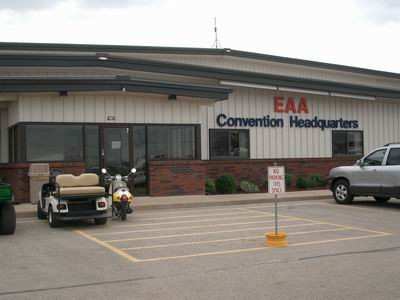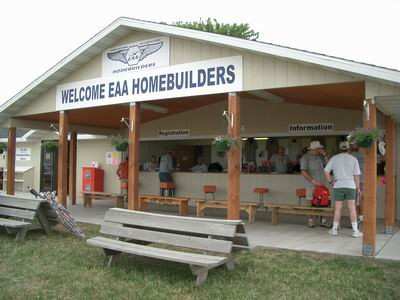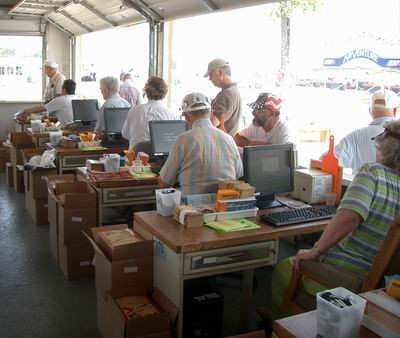Next Year's Planning Starts Next Week
By Aleta Vinas ANN Correspondent
The smooth, seamless appearance to aviation fans attending
AirVenture this week is a credit to the behind the scenes teamwork
of the EAA staff and volunteers.

After the gates close and the last transient aircraft has lifted
off, the planning begins for next year. Says Karen Fenner who works
in Convention Headquarters, "It's one continuous cycle."

EAA staffers often have several balls to juggle in addition to
AirVenture planning. Charlie Becker and Mark Forss cover the
Forums. Both are EAA staff and work in EAA Aviation Services. They
answer member phone calls, run the EAA sport air traveling
workshops, keep the homebuilders site on the EAA website and more.
Becker, on staff for six years says, "This is my dream job. I
turned my hobby into a career."
Forss gives a typical schedule for the AirVenture side of the
job. "During AirVenture, we're taking notes." In September there's
a debriefing with staff and chairpeople. In December they start
organizing to start contacting the presenters. In January and
February the letters are sent to the presenters. Late March and
early April a tentative schedule is made. The "final" schedule is
ready for printing by mid-June. The difficult part is weaving the
intricate tapestry that becomes the Forum schedule. The presenters
are all volunteers but there's no trouble getting even the heavy
hitters like Burt Rutan and Mike Melvill or Brian Binnie to
speak.
Becker likes to see the FAA Administrator and her staff at the
events, and "Getting them away from the cocoon in Washington." He
knows that the Administration's interaction with the pilots and
non-pilots is an invaluable tool to help them see what's really
going on.
Dennis Hasha, Chairman at the Homebuilt registration, has been
returning for 18 years. "Everyone's got their own little niche and
they come in and they take care of it and it all just melts
together to this wonderful airshow."

Pat Casetta, another 18 year volunteer, has been EAA Membership
Chairwoman for four years. After the show, she fills out an EAA
questionnaire on the show and offers suggestions. She also sends
thank you notes to her volunteers. She waits for the September
debriefing. February will start her next call to meet with the EAA
staff. The meetings continue to May.
In June, Casetta starts to send out the letters to her
volunteers. Her husband Dave helps her behind the scenes.
Orientation and training sessions follow, and then double checking
all the schedules. Casetta offers the fringe benefit of home
cooking for lunch. She cooks a few weeks in advance then freezes
the meals. From September to June she puts in about 30 hours. The
total after the show is about 200 hours.
Manager of EAA Facilities, Steve Taylor's phone doesn't stop
ringing. His work quadruples during AirVenture. The phone calls are
mostly little incidentals that crop up. Taylor and his staff of 25
full time, 25 part time and 400 volunteers are ready to handle
whatever job comes up. Taylor also starts planning for the next
year "right after the convention's over." He and his crew take care
of any issues so they're done before next spring. He tries to keep
in contact with his volunteers throughout the year. The work party
weekends generally start in May.
No matter what job people hold, everyone mentioned not being
able to have an airshow without the 4,500 volunteers. Also
mentioned were the relationships and the people; staff, volunteers
and visitors. Says Casetta " the best part is the people, it's like
a big reunion." Taylor says "It's the people you become associated
with that make it interesting."

Hasha sums it up, "I like airplanes, being around airplanes,
flying airplanes, talking about airplanes and I like being around
people that like airplanes. This is heaven to me for a week."
There are many people that work hard to make AirVenture heaven
for everyone for the week.
 Aero-News: Quote of the Day (12.18.25)
Aero-News: Quote of the Day (12.18.25) Classic Aero-TV: Viking Twin Otter 400--Bringing the DHC-6 Back Into Production
Classic Aero-TV: Viking Twin Otter 400--Bringing the DHC-6 Back Into Production NTSB Final Report: Rans Employee Flying Club Rans S-6ES Coyote II
NTSB Final Report: Rans Employee Flying Club Rans S-6ES Coyote II ANN FAQ: Submit a News Story!
ANN FAQ: Submit a News Story! ANN's Daily Aero-Term (12.18.25): Braking Action Advisories
ANN's Daily Aero-Term (12.18.25): Braking Action Advisories






